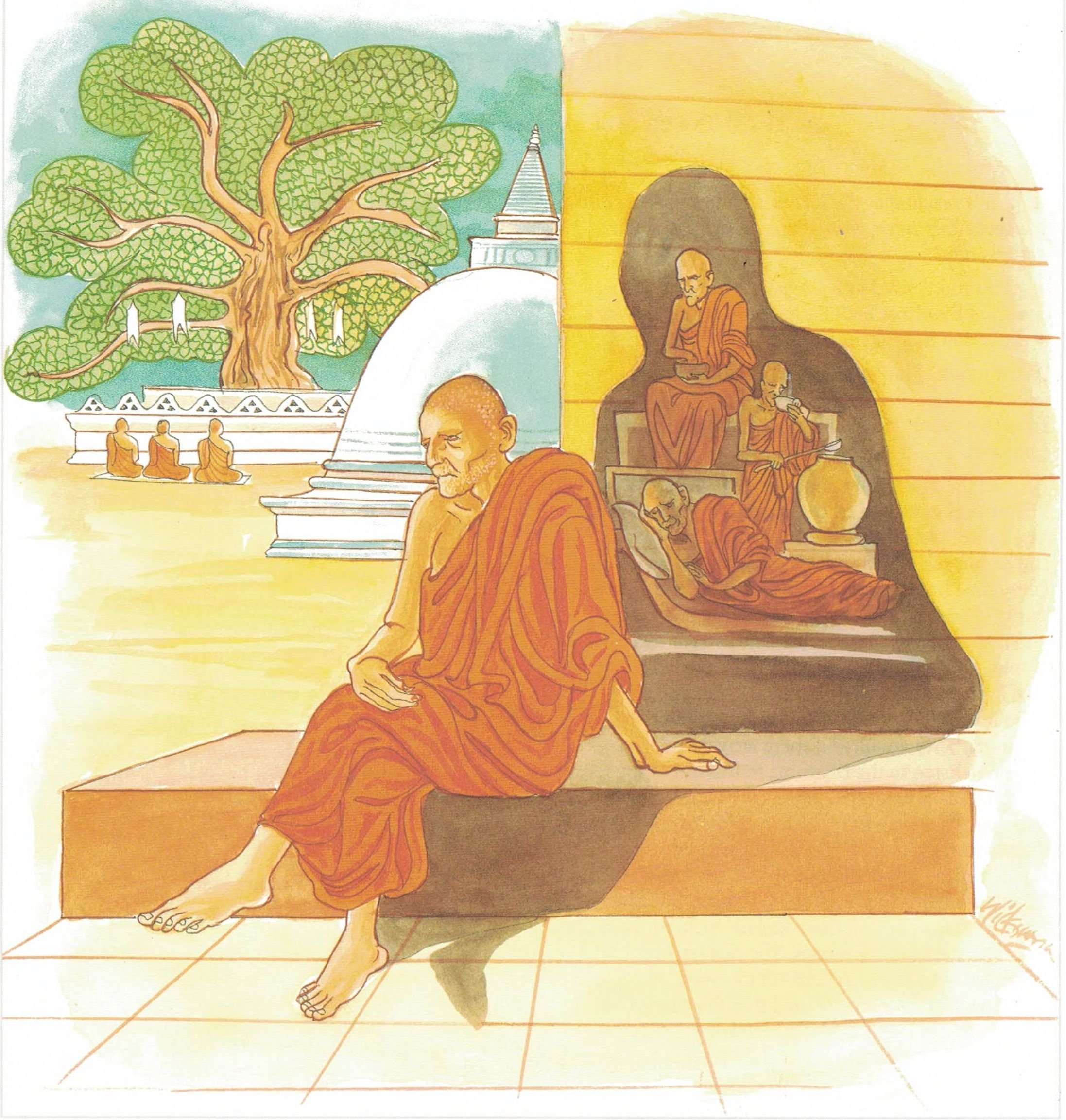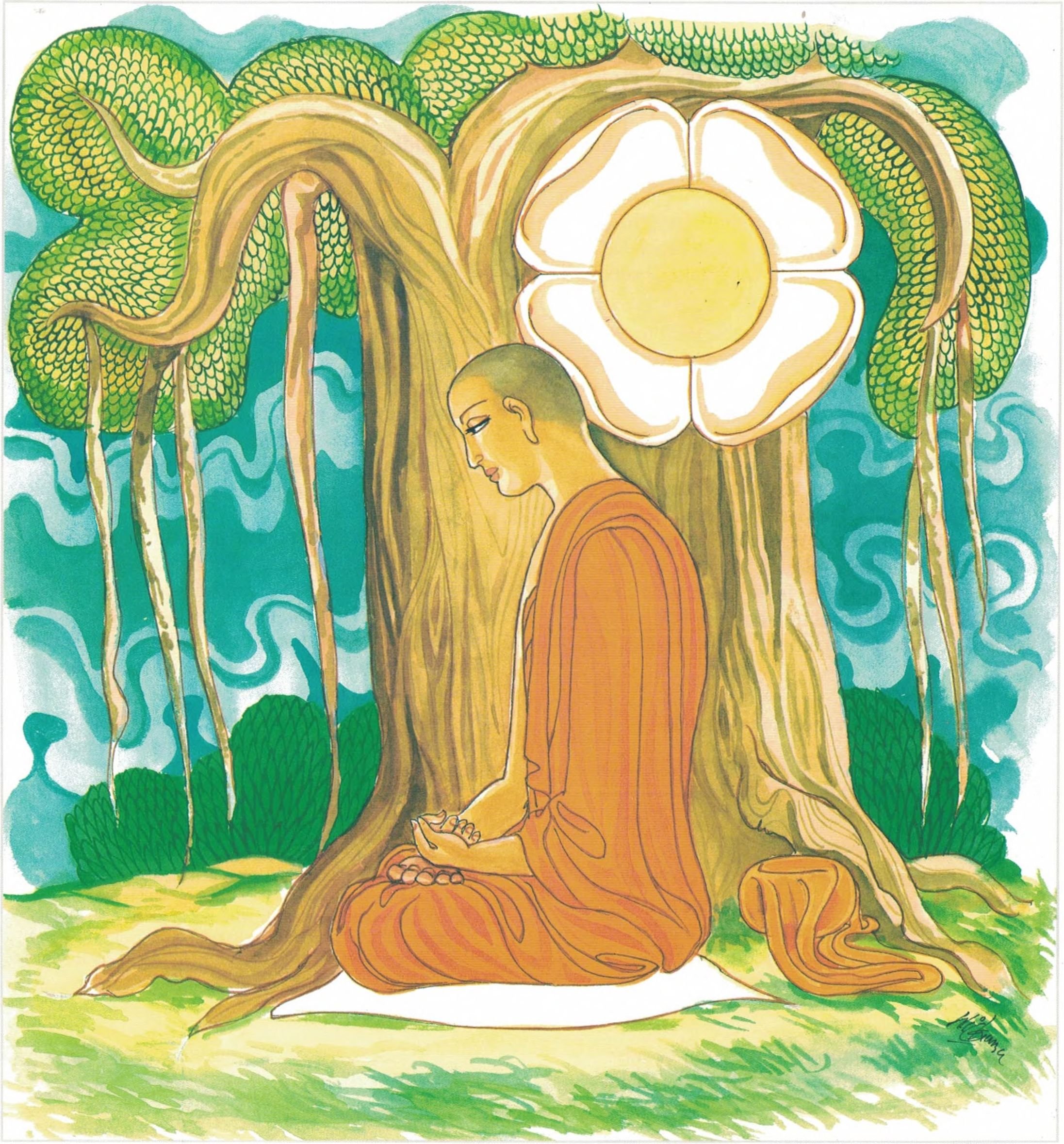Dhammapada (Illustrated)
by Ven. Weagoda Sarada Maha Thero | 1993 | 341,201 words | ISBN-10: 9810049382 | ISBN-13: 9789810049386
This page describes The Story of Venerable Lakuntaka Bhaddiya which is verse 260-261 of the English translation of the Dhammapada which forms a part of the Sutta Pitaka of the Buddhist canon of literature. Presenting the fundamental basics of the Buddhist way of life, the Dhammapada is a collection of 423 stanzas. This verse 260-261 is part of the Dhammaṭṭha Vagga (Established in Dhamma) and the moral of the story is “Grey hairs alone make no senior. Merely ripe in years, empty-in-age he is called” (first part only).
Verse 260-261 - The Story of Venerable Lakuṇṭaka Bhaddiya
Pali text, illustration and English translation of Dhammapada verse 260-261:
na tena thero hoti yen'assa palitaṃ siro |
paripakko vayo tassa moghajiṇṇo'ti vuccati || 260 ||
yamhi saccaṃ ca dhammo ca ahiṃsā saṃyamo damo |
sa ve vantamalo dhīro thero iti pavuccati || 261 ||
260. A man is not an Elder though his head be grey, he’s just fully ripe in years, ‘aged-in-vain’ he’s called.
261. In whom is truth and Dhamma too, harmlessness, restraint, control, he’s steadfast, rid of blemishes, an ‘Elder’ he is called.
 Grey hairs alone make no senior. Merely ripe in years, empty-in-age he is called. |
 Stainless, endowed with truth, virtue, love and restraint, such a steadfast one a true Elder is. |
The Story of Venerable Lakuṇṭaka Bhaddiya
While residing at the Jetavana Monastery, the Buddha spoke these verses with reference to Venerable Bhaddiya. He was also known as Lakuṇṭaka Bhaddiya because he was very short in stature.
For on a certain day this Venerable went to wait upon the Buddha. As he departed, thirty forest monks saw him. The monks went to the Buddha, saluted him, and sat down respectfully on one side. The Buddha, perceiving that they were ripe for arahatship, asked them this question, “Did you see a certain Venerable leave this place?” “No, Venerable, we did not.” “You did not?” ‘We saw a certain novice, Venerable.” “Monks, he was no novice; he was a Venerable.” “He was exceedingly young, Venerable.” “Monks, I do not call a man a Venerable merely because he is old, because he sits in the seat of a Venerable; but he who comprehends the Truths and is ever kind to others, he is a Venerable indeed.”
Explanatory Translation (Verse 260)
yena assa siro palitaṃ tena thero na hoti
tassa vayo paripakko moghajiṇṇo iti vuccati
yena: for some reason; assa: one’s; siro palitaṃ [palita]: hair becomes gray; tena: just because of that; thero na hoti: one does not become an elder; tassa vayo: his age; paripakko [paripakka]: becomes mature; moghajiṇṇo iti: ripe in years but not in virtue; vuccati: is called
One does not become an elder merely because one’s hair has turned grey. One who is only old in years has grown ripe uselessly.
Explanatory Translation (Verse 261)
yamhi saccaṃ ca dhammo ca ahiṃsā saññamo
damo vantamalo sa dhīro ve thero iti pavuccati
yamhi: if in an individual; saccaṃ ca: the fourfold truths; dhammo ca: the Buddha’s teaching; ahiṃsā: harmlessness; saññamo [saññama]: restraint; damo: discipline (are present); vantamalo [vantamala]: if he has got rid of the stains of defilements; sa: that person; dhīro [dhīra]: a person full of effort; ve: certainly; thero [thera]: true elder; iti pavuccati: (he) is called
All things that men do arise out of the mind. The words and deeds of men spring from their minds. Sometimes their minds are blemished–evil. If they speak or act with an evil mind, the inevitable result is suffering. Wherever they go this suffering will keep on following them. They cannot shake off this suffering. This is very much like the wheel of the cart that follows the steps of a draught bull yoked to the cart. The cartwheel keeps on following the bull. The bull is perpetually bound to it.
Commentary and exegetical material (Verse 260-261)
Thera: This term is applied to monks who have counted at least ten years in the Sangha from the date of their higher ordination. Thera, literally, means well established–one who is firm and stable. In English, this term is generally rendered as Elder. A monk who has completed twenty years in the Sangha is referred to as Mahā Thera (Great Venerable). In Sanskrit, the term for Thera is Sthavira. saccaṃ: truth. Here, the Four Noble Truths are meant.
Dhammo: The nine supramundane states are described as nine lokuttara Dhamma. They are the four paths and the four fruits, and the ninth is Nibbāna. The four paths and four fruits are:
- sotāpanna path
- sotāpanna fruit
- sakadāgāmi path
- sakadāgāmi fruit
- anāgāmi path
- anāgāmi fruit
- arahat path
- arahat fruit
- Nibbāna
As the traveller by night sees the landscape around him by a flash of lightning, and the picture so obtained swims long thereafter before his dazzled eyes, so the individual seeker, by the flashing light of insight, glimpses Nibbāna with such clarity that the after-picture never more fades from his mind.
When the spiritual pilgrim realizes Nibbāna for the first time, he is called a sotāpanna, one who has entered the stream that leads to Nibbāna for the first time. The stream represents the noble eightfold path.
A stream-winner is no more a worldling (puthujjana), but an ariya (noble).
On attaining this first stage of sainthood, he eradicates the following three fetters (saṃyojana) that bind him to existence known as:
(1) Sakkāya-diṭṭhi = sati + kāye–diṭṭhi–literally, view when a group or compound exists. Here, kāya refers to the five Aggregates of matter, feeling, perception, mental states, and consciousness. The view that there exists an unchanging entity, a permanent soul, when there is a complex compound of psycho-physical aggregates, is termed sakkāya-diṭṭhi. Dhammasangani enumerates twenty kinds of such soul-theories. Sakkāya-diṭṭhi is usually rendered as self-illusion, theory of individuality or illusion of individualism.
(2) Vicikicchā–doubts. They are doubts about (i) the Buddha, (ii) the Dhamma, (iii) the Sangha, (iv) the disciplinary rules (sikkhā), (v) the past, (vi) the future, (vii) both the past and the future, and (viii) dependent origination (Paṭicca-Samuppāda).
(3) Sīlabbataparāmāsa–adherence to (wrongful) rites & ceremonies.
Dhammasangani explains it thus: “It is the theory held by ascetics and brāhmins outside this doctrine that purification is obtained by rules of moral conduct, or by rites, or by both rules of moral conduct and rites.”
For the eradication of the remaining seven fetters, a sotāpanna is reborn seven times at the most. He gains implicit confidence in the Buddha, the Dhamma, and the Sangha. He would not, for any reason, violate any of the five precepts. He is not subject to rebirth in states of woe as he is destined to enlightenment.
With fresh courage as a result of this distant glimpse of Nibbāna, the noble pilgrim makes rapid progress and, perfecting his insight, becomes a sakadāgāmi (once-returner), the second stage of sainthood, by attenuating two other fetters–namely, sense-desires (kāmarāga) and ill-will (paṭigha).
Now, he is called a once-returner because he is born in the human realm only once should he not attain arahatship in that birth itself. It is interesting to note that the ariya saint, who has attained the second stage of sainthood, can only weaken these two powerful fetters with which he is bound from a beginningless past. At times, though to a slight extent, he may harbour thoughts of lust and anger.
It is by attaining the third stage of sainthood, that of the anāgāmi (never-returner), that he completely eradicates those two fetters. Thereafter, he neither returns to this world nor is he born in the celestial realms, since he has rooted out the desire for sensual gratification. After death, he is reborn in the pure abodes (suddhāvāsa), an environment reserved for anāgāmis. There, he attains arahatship and lives till the end of his life.
When a layman becomes an anāgāmi he leads a celibate life.
The anāgāmi saint now makes his final advance and, destroying the remaining five fetters–namely, attachment to Realms of Form (rūparāga), attachment to formless realms (arūparāga), pride (māna), restlessness (uddhacca), and ignorance (avijjā)–attains arahatship, the final stage of sainthood.
Stream-winners, once-returners and never-returners are called sekhas because they have yet to undergo a training. Arahats are called asekhas (adepts) because they no more undergo any training.
An arahat, literally a worthy one, is not subject to rebirth because he does not accumulate fresh kammic activities. The seeds of his reproduction have all been destroyed.
